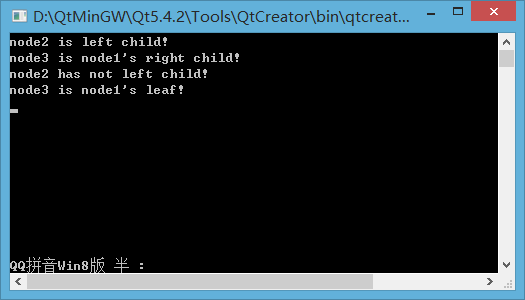获取二叉树高度的代码链接:https://blog.csdn.net/tcherry/article/details/25822417
测试是否有左孩子 hasLChild(x)、右孩子函数 hasRChild(x),以及是否右孩子函数 hasChild(x) 。
节点头文件:
#ifndef BINNODE_H #define BINNODE_H #include <iostream> //*************************************************************************************** ///代码5.2 , BinNode状态与性质的判断 ///一、 判断该节点是什么! /// 是否是根节点、是否是左子节点、是否是右子节点、是否是叶节点 #define isRoot(x) (!((x).parent)) #define isLChild(x) (!isRoot(x)&&(&(x)==(x).parent->lc)) //不是根节点,同时必须是父节点的左孩子 #define isRChild(x) (!isRoot(x)&&(&(x)==(x).parent->rc)) //不是根节点,同时必须是父节点的右孩子 ///二、判断该节点有什么 //判断是否有孩子 #define hasLChild(x) ((x).lc!=NULL) //判断节点x是否有左孩子 #define hasRChild(x) ( (x).rc ) //判断节点x 是否有右孩子 #define hasChild(x) ( hasLChild(x)||hasRChild(x)) //判断节点x是否有孩子(左、右至少有一个) //判断是否为叶节点 #define isLeaf(x) ( !hasChild(x) ) //判断节点x是否是叶子节点 //**************************************************************************************** #define BinNodePosi(T) BinNode<T>* //节点位置 typedef enum{RB_RED,RB_BLACK} RBColor;//节点颜色 template <typename T> class BinNode { public: T data;//数值 int height; int npl;//Null Path Length(左式堆,也可直接用height代替) RBColor color; BinNodePosi(T) parent;//父节点 BinNodePosi(T) lc;//左子节点 BinNodePosi(T) rc;//右子节点 //构造函数 BinNode():parent(NULL),lc(NULL),rc(NULL),height(0),npl(1),color(RB_RED){} BinNode(T e,BinNodePosi(T) p=NULL,BinNodePosi(T) lc=NULL,BinNodePosi(T) rc=NULL, int h=0,int l=1,RBColor c=RB_RED) { data=e; parent=p; this->lc=lc,this->rc=rc;//此处添加this指针,以便将成员变量lc、rc与形参lc和rc区分 height=h; npl=l; color=c; } }; #endif // BINNODE_H
下面是测试实例代码:
#include <iostream> #include <binnode.h> #include <string> using namespace std; //1、测试根节点函数isRoot void testRoot(BinNode<string> &node) { if(isRoot(node)) cout<<node.data<<" is root!"<<endl; else cout<<node.data<<" is not a root!"<<endl; } //2、测试左孩子函数isLChild void testLChild(BinNode<string> &node) { if(isLChild(node)) cout<<node.data<<" is left child!"<<endl; else cout<<node.data<<" is not left child!"<<endl; } //3、测试右孩子函数isRChild void testRChild(BinNode<string> &node) { if(isRChild(node)) cout<<node.data<<" is "<<node.parent->data<< "'s right child!"<<endl; else cout<<node.data<<" is not right child!"<<endl; } //4、测试是否有左孩子函数 void testHasLChild(BinNode<string> &node) { if(hasLChild(node)) cout<<node.data<<" has a left child: "<<endl; else cout<<node.data<<" has not left child!"<<endl; } //5、测试是否是叶节点函数isLeaf() void testLeaf(BinNode<string> &node) { if(isLeaf(node)) cout<<node.data<<" is "<<node.parent->data<< "'s leaf!"<<endl; else cout<<node.data<<" is not leaf"<<endl; } int main() { BinNode<string> n1("node1"); BinNode<string> n0("node0"); BinNode<string> n2("node2"); BinNode<string> n3("node3"); //2、将n2设定为n1的左节点,测试isLChild()函数 n1.lc=&n2; n2.parent=&n1; testLChild(n2); //3、将n3设定为n1的右节点,测试isRChild()函数 n1.rc=&n3; n3.parent=&n1;//创建n1、n3之间的父子关系 testRChild(n3); //4、测试n3是否有左孩子 testHasLChild(n2); //5、测试叶节点函数isLeaf testLeaf(n3); return 0; }
下面是测试结果:
